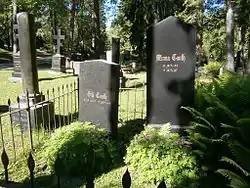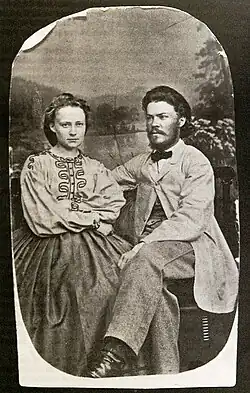Minna Canth
Minna Canth (Finnish pronunciation: [minːɑ kɑnt]; born Ulrika Wilhelmina Johnson; 19 March 1844 – 12 May 1897)[1][2] was a Finnish writer and social activist. Canth began to write while managing her family draper's shop and living as a widow raising seven children. Her work addresses issues of women's rights, particularly in the context of a prevailing culture she considered antithetical to permitting expression and realization of women's aspirations. The Worker's Wife and The Pastor's Family are her best known plays, but the play Anna Liisa is the most adapted to the films and operas. In her time, she became a controversial figure, due to the asynchrony between her ideas and those of her time, and in part due to her strong advocacy for her point of view.
Minna Canth | |
|---|---|
 Photograph of Minna Canth by Victor Barsokevitsch | |
| Born | Ulrika Wilhelmina Johnson 19 March 1844 Tampere, Finland |
| Died | 12 May 1897 (aged 53) Kuopio, Finland |
| Occupation(s) | writer, playwright |
| Notable work | The Pastor's Family The Worker's Wife Anna Liisa |
| Spouse | Johan Ferdinand Canth (husband) |
| Children | Anni Canth (daughter) Elli Canth (daughter) Hanna Canth (daughter) Maiju Canth (daughter) Jussi Canth (son) Pekka Canth (son) Lyyli Canth (daughter) |
| Parent(s) | Gustaf Vilhelm Johnson (father) Lovisa Ulrika Archelin (mother) |
Minna Canth was the first major Finnish-language playwright and prose writer after Aleksis Kivi, the national author of Finland, and the first Finnish-language newspaper woman.[3][4] She was also the first woman to receive her own flag flying day in Finland, starting on 19 March 2007. It is also the day of social equality in Finland.
Life and career
Canth was born in Tampere to Gustaf Vilhelm Johnsson (1816–1877) and his wife Ulrika (1811–1893). Her father worked at James Finlayson's textile factory initially as a worker and later as a foreman. Gustaf and Ulrika had four children, Minna included, of whom the eldest, Adolf, died in infancy. Minna's surviving siblings were Gustaf (1850–1894) and Augusta (1852–1877). In 1853 his father was given charge of Finlayson's textile shop in Kuopio and the entire family relocated there.[5]
Canth received an exceptionally thorough education for a working-class woman of her time. Even before moving to Kuopio she had attended school at Finlayson's factory which was intended for the workers' children. In Kuopio she continued to go to various girls' schools and as a testament to her father's success as a shopkeeper, she was even admitted into a school intended for upper class children. In 1863 she began her studies at the recently founded Jyväskylä Teacher Seminary, which was the first school in Finland to offer higher education for women.[6]
In 1865 she married her natural sciences teacher, Johan Ferdinand Canth (1835–1879), and had to drop out of the Seminary.[7] Between 1866 and 1880 she gave birth to seven children: Anni (1866–1911), Elli (1868–1944), Hanna (1870–1889), Maiju (1872–1943), Jussi (1874–1929), Pekka (1876–1959) and Lyyli (1880–1969);[8] her husband Johan died in 1879 shortly before the birth of the family's seventh child.[7] She began her writing career at the newspaper Keski-Suomi, where her husband worked as an editor. She wrote about women's issues and advocated temperance. In 1876 the Canths were forced to leave the paper because Minna's writings had roused some bad blood; they were, however, both employed by the competing Päijänne the following year. Minna published her first works of fiction on the pages of Päijänne: various short stories, which were compiled in her first book, Novelleja ja kertomuksia, in 1878.[2][9]

Canth died suddenly of a heart attack at the age of 53 on May 12, 1897 at her home in Kuopio.[10] She was buried in a family grave in Kuopio Cemetery.
Debate

Canth stood out when there was public debate about women's rights. In 1885 a bishop had argued that God's order required that women were not emancipated. The writer Gustaf af Geijerstam then argued that men could only aspire to one day have the purity of women because they were fundamentally different and this was the reason for prostitution and other immorality. Canth objected strongly to this argument as it meant that men could defend their poor morals by reference to their implicit shortcomings, whereas any women involved in prostitution would lack the same defence.[11]
Most important works

Minna Canth published a total of ten plays, seven short stories, as well as newspaper articles and speeches.[3] As a central representative of realism of her time, she mainly looked at the ills of society in her works.[12] Canth's most important works are the plays Työmiehen vaimo (The Worker's Wife) from 1885 and Anna Liisa, penned in 1895.
In Työmiehen vaimo, the main character Johanna is married to Risto, an alcoholic who wastes all his wife's money. Johanna cannot prevent him – her money is legally his, not hers. The play's premiere caused scandal, but a few months later, parliament enacted a new law about separation of property.[13]
Anna Liisa is a tragedy about a fifteen-year-old girl who gets pregnant without being married – she manages to hide her pregnancy, and when the child is born, she suffocates it in a fit of panic. Her boyfriend Mikko's mother helps her – she buries the baby in the woods, but a few years later, when Anna Liisa wants to marry her fiancé Johannes, she is blackmailed by Mikko and his mother. They threaten her to reveal her dark secret if she does not agree to marry Mikko, but Anna Liisa refuses. In the end, she decides to confess what she has done. She is taken to prison, but is much relieved after owning up and seems to have found peace.[14]
In popular culture
A two-part television mini-series about Minna Canth called Minna, written by Lauri Leskinen and directed by Mauno Hyvönen, was released in 1977.[15] In the mini-series, Minna Canth is played by Anja Pohjola. [16]
In 2022, an opera called Minnan taivas about Minna's life and work was staged in Finland, written by Veera Airas with composer Jukka Linkola.[17][18][19]
Tribute
Canth is remembered in Finland for its numerous landmarks, publications, medals, commemorative coins, stamps, paintings, plays, exhibitions and events. Many different construction sites and places have been named after her, along with several cultural clubs and other communities.[20] The Finnish Fair Foundation (Suomen Messusäätiö) has funded the Minna Canth Prize, which is awarded annually to the “shaker of our society” at the Helsinki Book Fair. The prize is 5,000 euros.[21]
The statues of Minna Canth have been erected in Kuopio, Tampere and Jyväskylä, from which the statue in Kuopio was unveiled on 12 May 1937.[20] The city of Kuopio has also organized Canth's anniversaries on several occasions, such as an event called Minnan päivät ("Days of Minna"),[22] either during the tenth anniversary of her birth or death; for example, the 21st century has already been celebrated twice, in 2004 and 2007.[23][24]
On 19 March 2017, Google celebrated her 173rd birthday with a Google Doodle.[25]
Translations
Canth, Minna: The Burglary and The House of Roinila. Translated into English by Richard Impola. Aspasia Books, Beaverton 2010.
Further reading
Sirkka Sinkkonen, editor (1986) Toward equality: proceedings of the American and Finnish Workshop on Minna Canth, Kuopio, 19 to 20 June 1985. University of Kuopio. ISBN 951-780-823-2.
References
- Minna Canth at the Encyclopædia Britannica
- Maijala, Minna. "Minna Canth (1844–1897)". Klassikkogalleria. Kristiina Institute, University of Helsinki. Retrieved 31 March 2017.
- Vuorikari, Outi. "Minnan elämäkerta lyhyesti". Minnan Salonki (in Finnish). Kuopion kaupunginkirjasto – Pohjois-Savon maakuntakirjasto. Archived from the original on 31 March 2016. Retrieved 16 March 2021.
- Tellervo Krogerus: Canth, Minna (1844–1897), The National Biography of Finland, vol 2, pp. 103–106. Helsinki: Finnish Literature Society, 2003. ISBN 951-746-443-6. (in Finnish)
- Vuorikari, Outi. "Myrskylintu Tampereelta". Minna Canth. Kuopio Museum of Cultural History. Retrieved 30 March 2017.
- Vuorikari, Outi. "Kauppiaan tyttären koulut". Minna Canth. Kuopio Museum of Cultural History. Retrieved 30 March 2017.
- Lasse Koskela: Suomalaisia kirjailijoita Jöns Buddesta Hannu Ahoon, p. 40–42. Tammi, 1990. (in Finnish)
- "Elämäkerta: Perhe". Minna Canth 1844–1897 (in Finnish). Kuopion kaupunki. Archived from the original on 20 July 2011. Retrieved 10 December 2020.
- Vuorikari, Outi. "Minna Canthin monet roolit Jyväskylässä". Minna Canth. Kuopio Museum of Cultural History. Retrieved 31 March 2017.
- Paananen, Karoliina (14 March 2019). "Mitä 175 vuotta sitten syntynyt Minna Canth olisi miettinyt vanhustenhuollon ongelmista?". Ilta-Sanomat (in Finnish). Retrieved 10 December 2020.
- Jaakko Ahokas (1973). A History of Finnish Literature. Taylor & Francis. p. 113. ISBN 978-0-87750-172-5.
- Lasse Koskela: Suomalaisia kirjailijoita Jöns Buddesta Hannu Ahoon, p. 40–42. Tammi, 1990. (in Finnish)
- Minna Canth | Näytelmät (in Finnish)
- Minna Canthin tuotanto - Kuopion Kulttuurihistoriallinenmuseo (in Finnish)
- Minna (TV Mini-Series 1977) – IMDb
- HS: Anja Pohjola loistaa pääosassa, mutta muuten 70-luvun tv-draama Minna Canthista on aikansa elänyt (in Finnish)
- https://www.youtube.com/watch?v=5ggoP6kiG-M
- https://savo-ooppera.fi/oopperasta/
- https://www.kuopionmusiikkikeskus.fi/kaupunginorkesteri/minnan-taivas-ooppera-ensi-iltaan-syyskuussa-2022/
- Minna Canth eilen ja tänään Archived 20 May 2008 at the Wayback Machine - Julkaisija = Suomen kirjailijanimikkoseurat ry (in Finnish)
- Ensimmäistä kertaa jaettava Minna Canth -palkinto annetaan yhteiskuntamme ravistelijalle. - Messukeskus (in Finnish)
- Minnan päivät - Kuopio Festivals (in Finnish)
- Tapahtumat 2004: Tämän päivän Minnat -luento: kirjailija Sirpa Kähkönen - Kuopio University (in Finnish)
- Minna Canth juhlavuosi 2007 Kuopiossa Archived 22 May 2008 at the Wayback Machine - Kuopio Festivals (in Finnish)
- "Minna Canth's 173rd Birthday". Google. 19 March 2017.